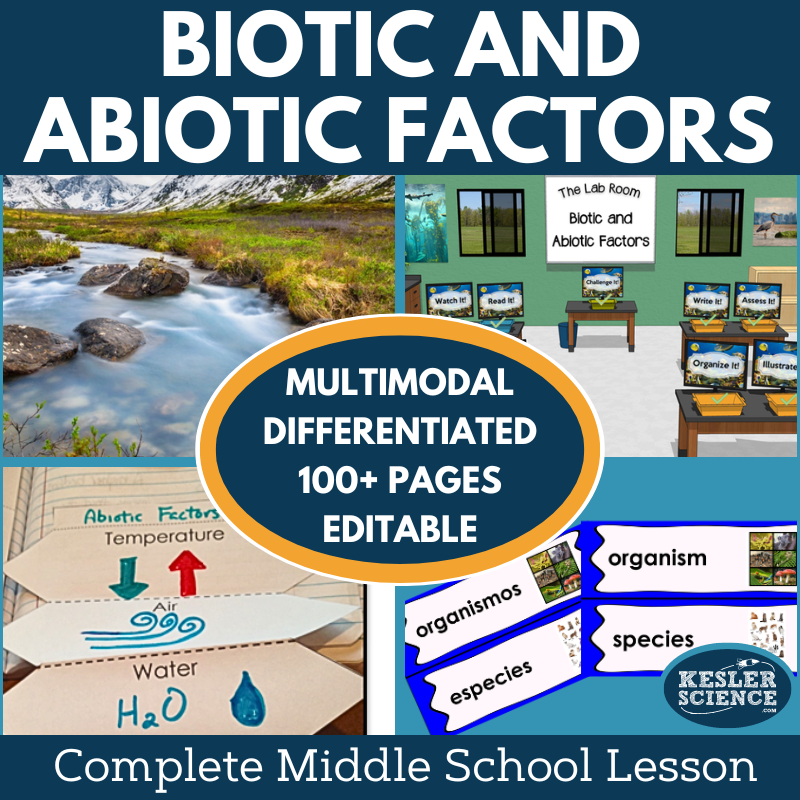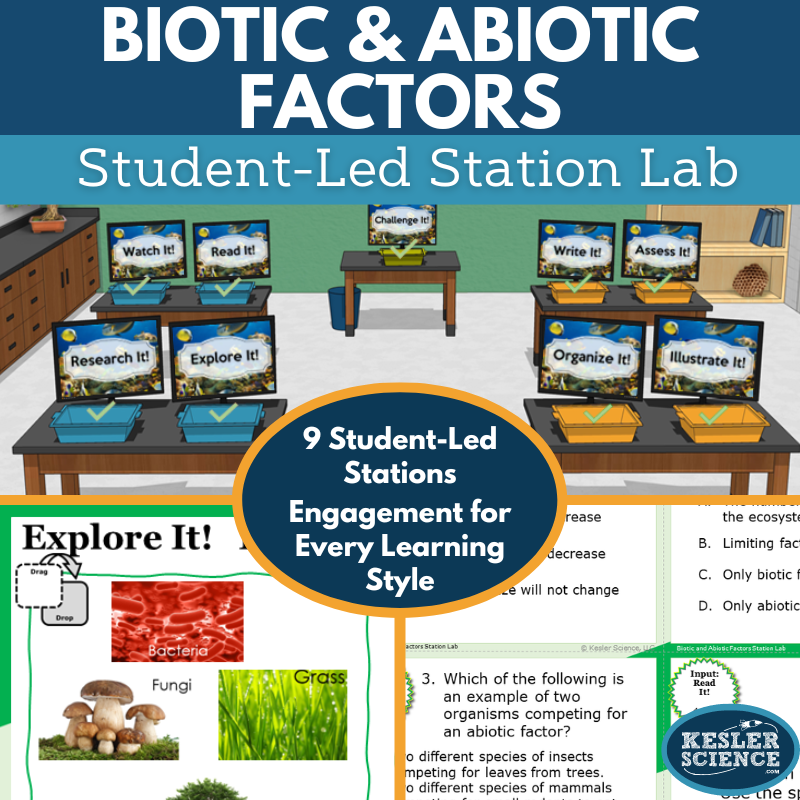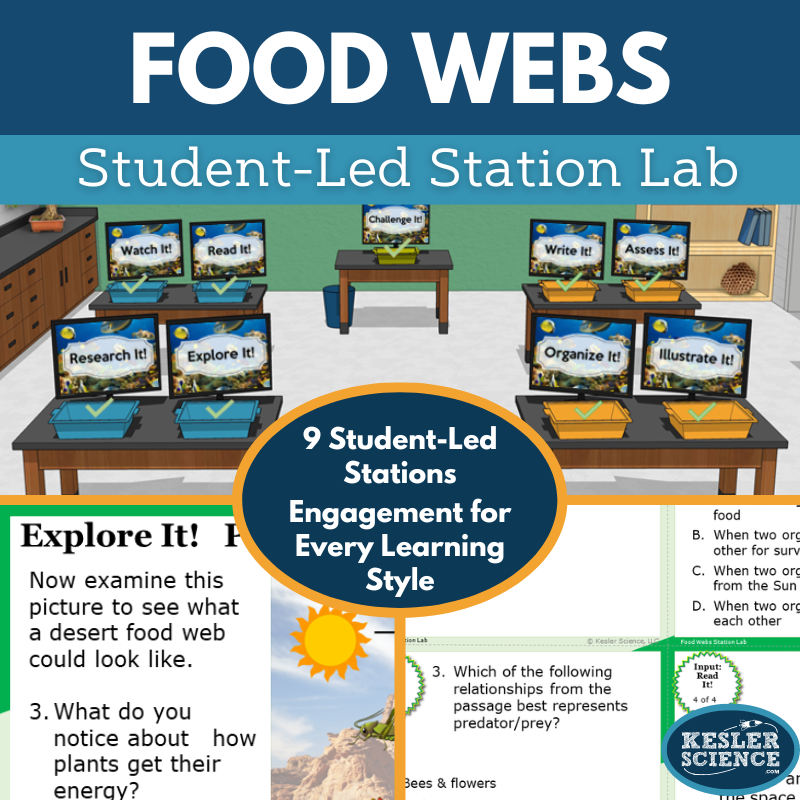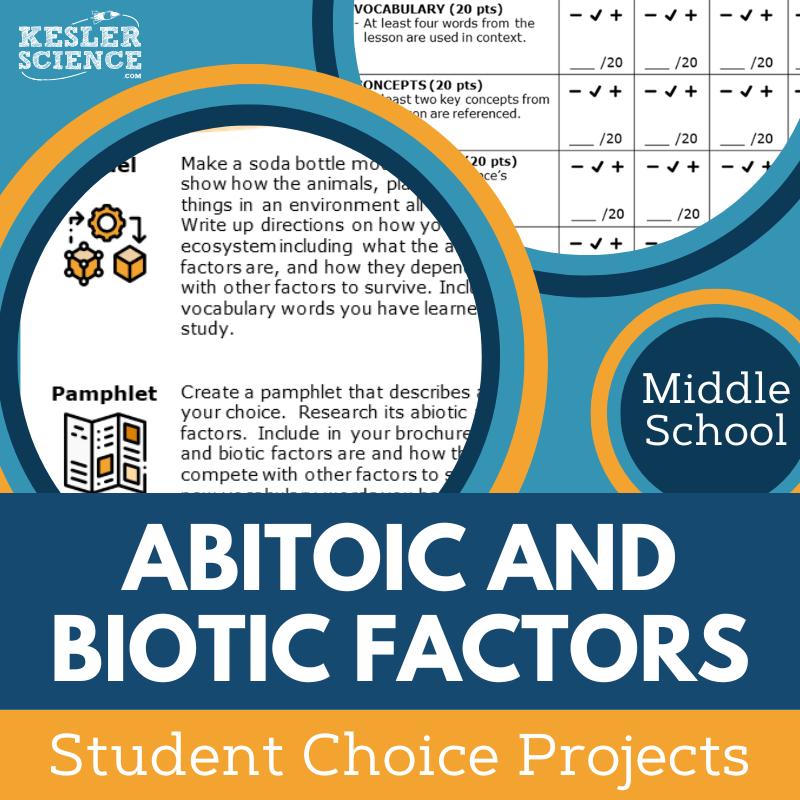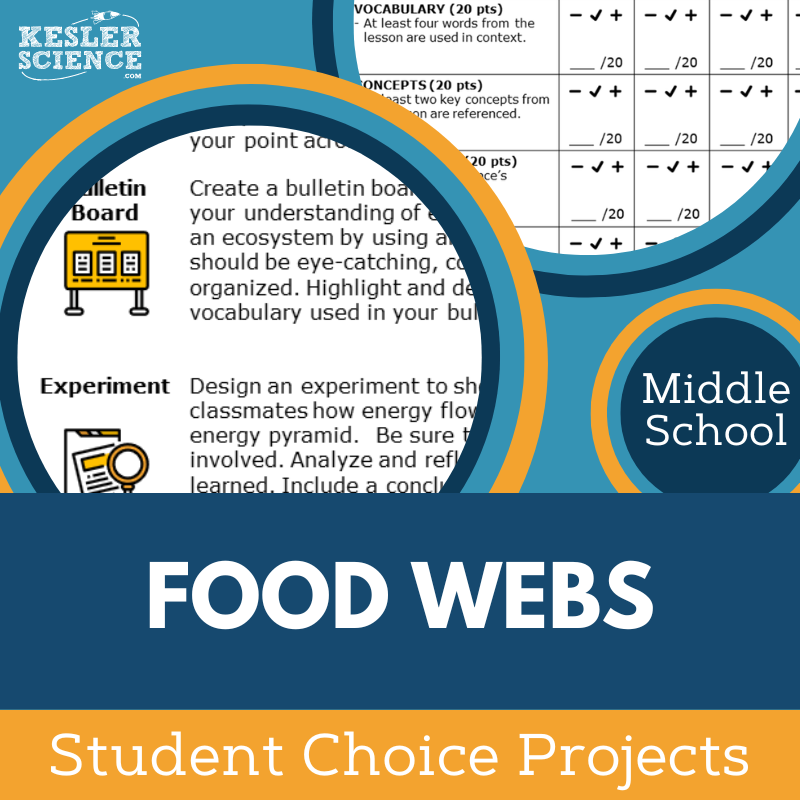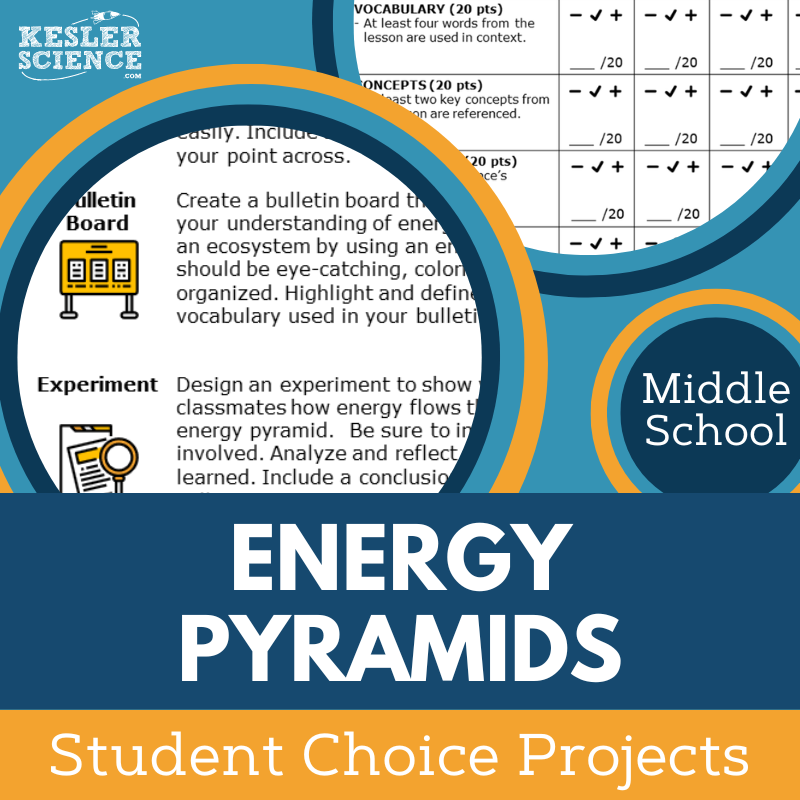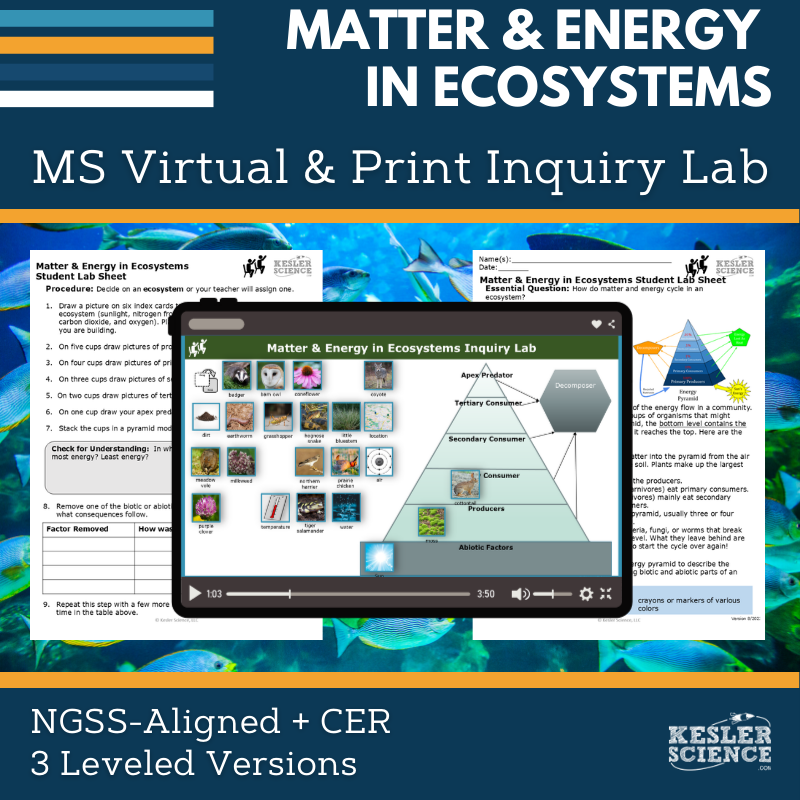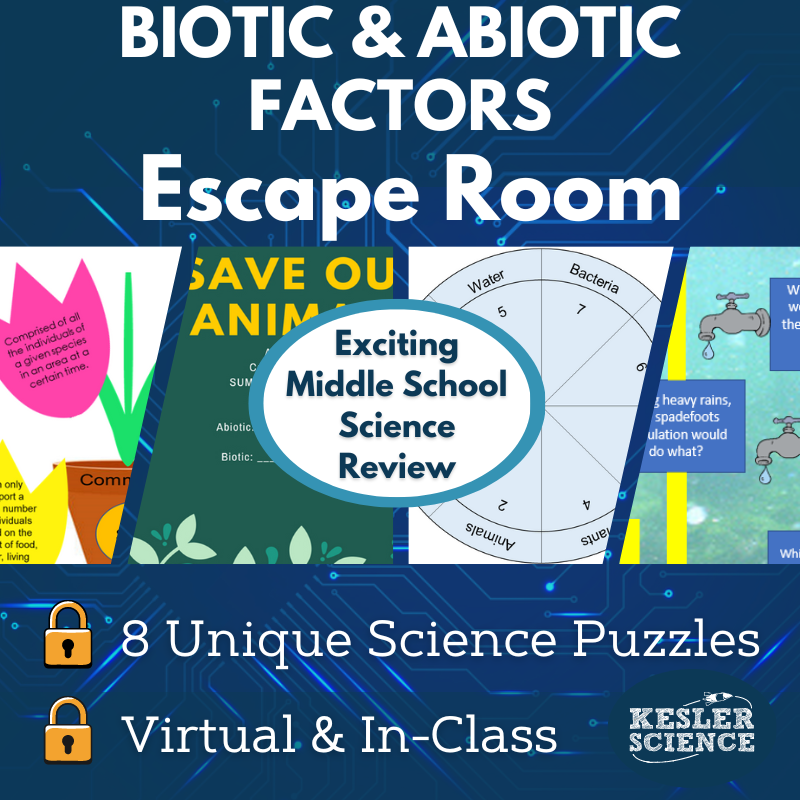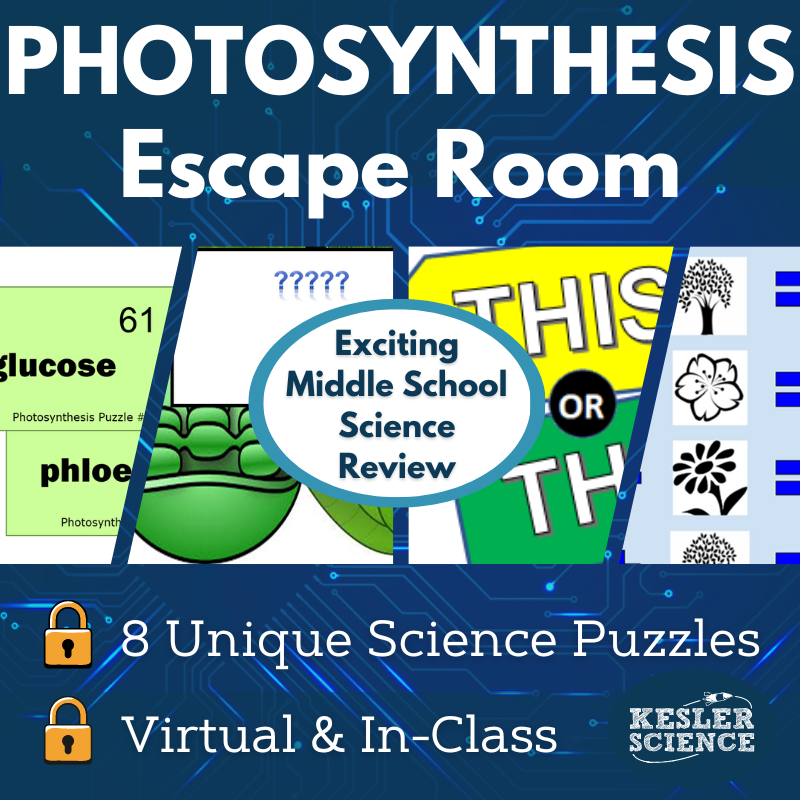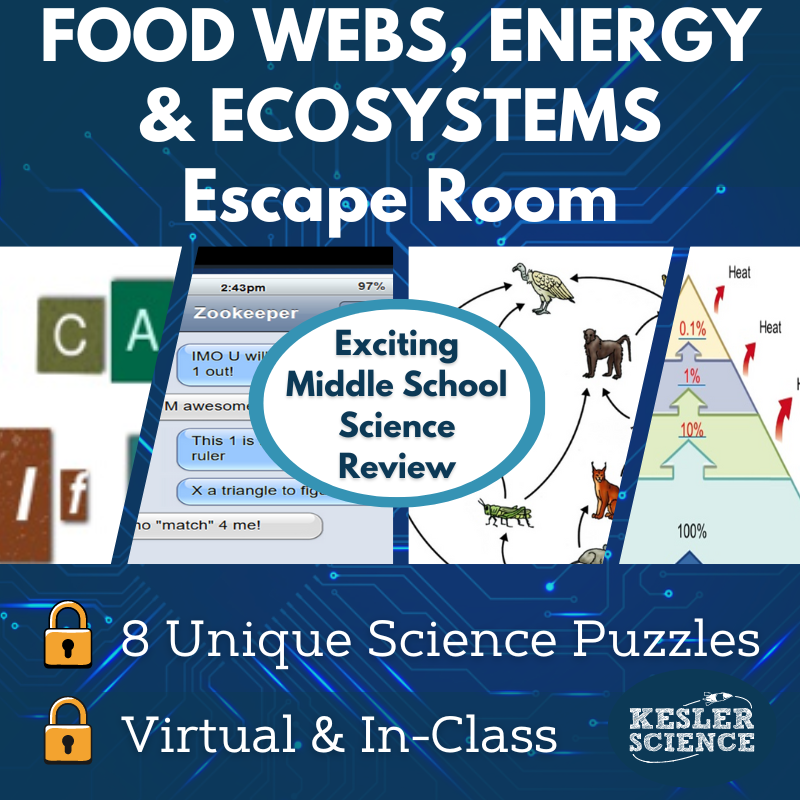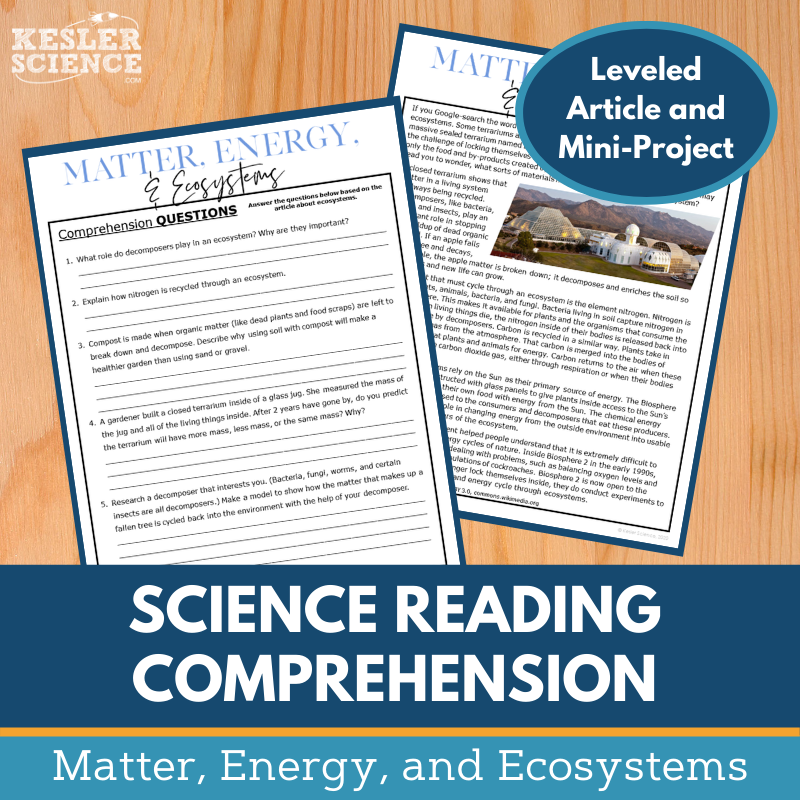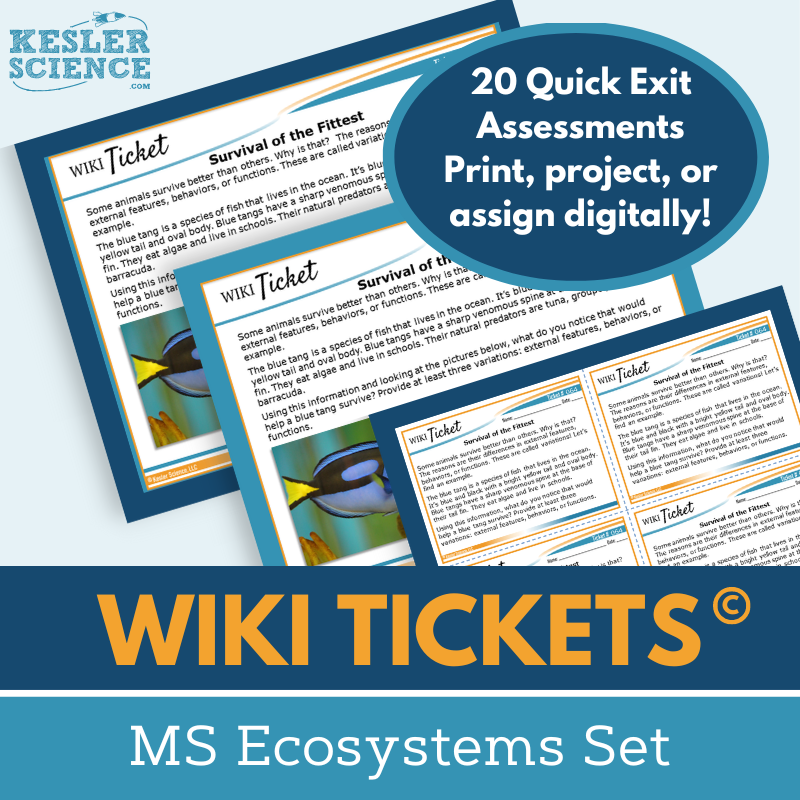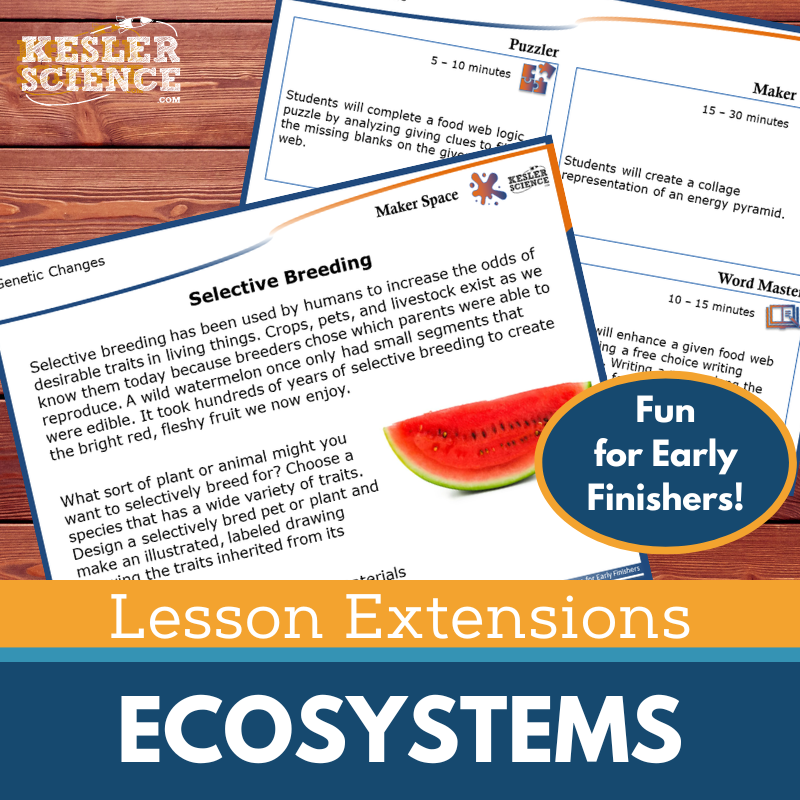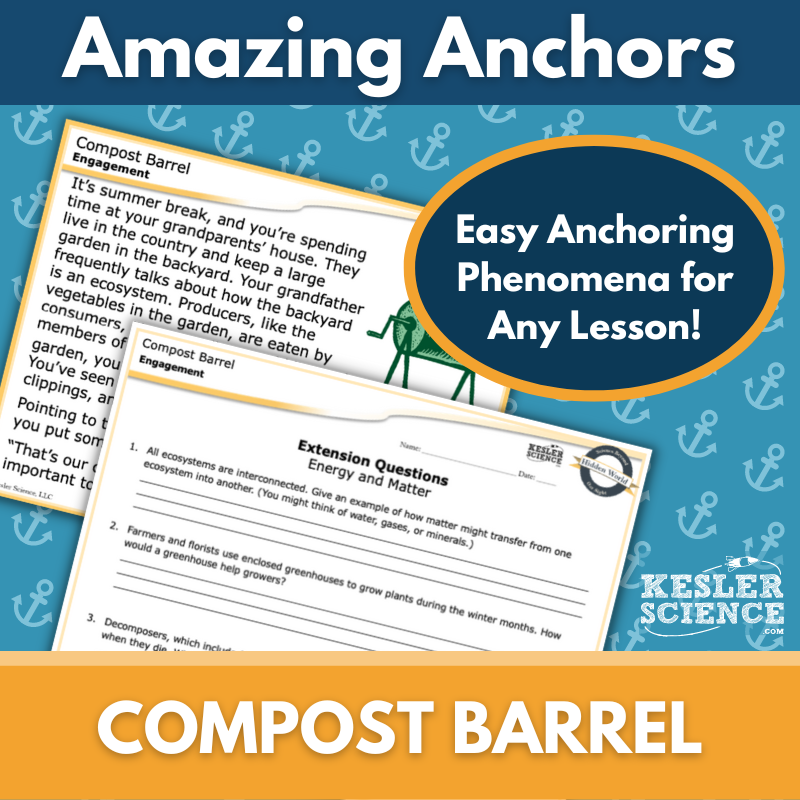Matter & Energy in Ecosystems Activities for Middle School Science
These engaging 5E lessons guide middle school students in exploring biotic and abiotic factors, food webs, and energy pyramids through hands-on, student-led learning. The resources below will give students a comprehensive understanding of matter and energy in ecosystems. All of the following materials are also included in the Kesler Science Membership.
The Kesler Science Biotic and Abiotic Factors 5E Lesson provides an engaging and comprehensive middle school science unit aligned with NGSS standards. It uses the research-based 5E model—Engagement, Exploration, Explanation, Elaboration, and Evaluation—to explore how organisms depend on and compete for biotic and abiotic factors in ecosystems.
This student-led lesson includes differentiated and multimodal materials such as editable PowerPoints, interactive notebooks, worksheets, choice projects, and assessments to meet diverse learner needs. In the Exploration phase, students engage in a differentiated station lab with hands-on experiments, readings, research, videos, and interactive tasks to deepen their understanding. The lesson also supports bilingual learners with resources available in both English and Spanish.
Flexible formatting allows for easy adaptation for classroom or virtual use, requiring minimal preparation. Additionally, students extend their learning through choice projects, while assessments aligned with STAAR 2.0 standards effectively evaluate student mastery.
The Kesler Science Biotic and Abiotic Factors 5E Lesson provides an engaging and comprehensive middle school science unit aligned with NGSS standards. It uses the research-based 5E model—Engagement, Exploration, Explanation, Elaboration, and Evaluation—to explore how organisms depend on and compete for biotic and abiotic factors in ecosystems.
This student-led lesson includes differentiated and multimodal materials such as editable PowerPoints, interactive notebooks, worksheets, choice projects, and assessments to meet diverse learner needs. In the Exploration phase, students engage in a differentiated station lab with hands-on experiments, readings, research, videos, and interactive tasks to deepen their understanding. The lesson also supports bilingual learners with resources available in both English and Spanish.
Flexible formatting allows for easy adaptation for classroom or virtual use, requiring minimal preparation. Additionally, students extend their learning through choice projects, while assessments aligned with STAAR 2.0 standards effectively evaluate student mastery.
This middle school unit on food webs and energy flow through ecosystems includes presentations, worksheets, choice projects, and assessments. It is fully editable and requires minimal prep, offering differentiated, student-led learning that promotes engagement. Students will explore essential questions about energy flow in living systems and food webs in different ecosystems.
The unit follows the 5E Model, covering Engagement, Exploration, Explanation, Elaboration, and Evaluation. Engagement activities include vocabulary cards and a teacher file with class discussion ideas. Exploration features differentiated, student-led stations that allow for multimodal learning, including hands-on demos, readings, research tasks, videos, and interactive activities. Output stations let students demonstrate their understanding through activities like sorting, writing, illustrating, and assessments. A bonus “Challenge It!” station offers extension activities for early finishers.
Explanation includes editable PowerPoints, interactive notebooks, and note-taking templates. Elaboration provides student-choice projects to extend learning, and Evaluation includes updated STAAR 2.0 assessment questions and review materials. This unit is flexible for both classroom and virtual learning environments.
This middle school unit on food webs and energy flow through ecosystems includes presentations, worksheets, choice projects, and assessments. It is fully editable and requires minimal prep, offering differentiated, student-led learning that promotes engagement. Students will explore essential questions about energy flow in living systems and food webs in different ecosystems.
The unit follows the 5E Model, covering Engagement, Exploration, Explanation, Elaboration, and Evaluation. Engagement activities include vocabulary cards and a teacher file with class discussion ideas. Exploration features differentiated, student-led stations that allow for multimodal learning, including hands-on demos, readings, research tasks, videos, and interactive activities. Output stations let students demonstrate their understanding through activities like sorting, writing, illustrating, and assessments. A bonus “Challenge It!” station offers extension activities for early finishers.
Explanation includes editable PowerPoints, interactive notebooks, and note-taking templates. Elaboration provides student-choice projects to extend learning, and Evaluation includes updated STAAR 2.0 assessment questions and review materials. This unit is flexible for both classroom and virtual learning environments.
The Kesler Science Energy Pyramids unit is a comprehensive middle school lesson focused on understanding energy flow in ecosystems. It includes editable PowerPoints, worksheets, choice projects, and assessments. Designed for minimal prep, the lesson fosters differentiated, student-led learning, allowing teachers to focus on student success.
The lesson is aligned with NGSS MS LS1-6 and MS LS2-3 standards. It features a 5E model structure with engaging activities across all phases: engagement, exploration, explanation, elaboration, and evaluation. Students explore energy pyramids through nine differentiated exploration stations, including hands-on experiments, reading passages, research tasks, and videos. Output stations allow students to demonstrate their understanding through sorting, writing, illustrating, and assessment activities.
The unit also includes editable PowerPoints, interactive notebooks (available in English and Spanish), and student-choice projects. For virtual learning, all materials, including the exploration stations and PowerPoints, are designed for flexible online or in-person use. Assessments are updated for STAAR 2.0, and bonus stations provide enrichment for early finishers.
The Kesler Science Energy Pyramids unit is a comprehensive middle school lesson focused on understanding energy flow in ecosystems. It includes editable PowerPoints, worksheets, choice projects, and assessments. Designed for minimal prep, the lesson fosters differentiated, student-led learning, allowing teachers to focus on student success.
The lesson is aligned with NGSS MS LS1-6 and MS LS2-3 standards. It features a 5E model structure with engaging activities across all phases: engagement, exploration, explanation, elaboration, and evaluation. Students explore energy pyramids through nine differentiated exploration stations, including hands-on experiments, reading passages, research tasks, and videos. Output stations allow students to demonstrate their understanding through sorting, writing, illustrating, and assessment activities.
The unit also includes editable PowerPoints, interactive notebooks (available in English and Spanish), and student-choice projects. For virtual learning, all materials, including the exploration stations and PowerPoints, are designed for flexible online or in-person use. Assessments are updated for STAAR 2.0, and bonus stations provide enrichment for early finishers.
Engage your middle school students with this modular, student-led station lab aligned with NGSS standards, exploring biotic and abiotic factors in ecosystems. Students independently identify, compare, and apply concepts through nine differentiated stations featuring multimodal activities such as hands-on tasks, interactive research, reading passages in English and Spanish, and videos.
Input stations like Explore It!, Research It!, Read It!, and Watch It! introduce foundational concepts through interactive tasks, digital manipulation of images and text, and guided readings. Output stations, including Organize It!, Illustrate It!, Write It!, and Assess It!, allow students to demonstrate understanding through models, writing, manipulatives, and assessments. An additional Challenge It! station provides extension activities such as crosswords, games, and mini-projects for early finishers.
Designed for both classroom and virtual settings, this student-centered resource promotes personalized learning, active engagement, and critical thinking.
Engage your middle school students with this modular, student-led station lab aligned with NGSS standards, exploring biotic and abiotic factors in ecosystems. Students independently identify, compare, and apply concepts through nine differentiated stations featuring multimodal activities such as hands-on tasks, interactive research, reading passages in English and Spanish, and videos.
Input stations like Explore It!, Research It!, Read It!, and Watch It! introduce foundational concepts through interactive tasks, digital manipulation of images and text, and guided readings. Output stations, including Organize It!, Illustrate It!, Write It!, and Assess It!, allow students to demonstrate understanding through models, writing, manipulatives, and assessments. An additional Challenge It! station provides extension activities such as crosswords, games, and mini-projects for early finishers.
Designed for both classroom and virtual settings, this student-centered resource promotes personalized learning, active engagement, and critical thinking.
This student-led Food Webs Station Lab keeps middle school students engaged while teaching them about ecosystems. The lab features eight differentiated stations and a bonus challenge station for early finishers, allowing students to direct their own learning. Each station includes signage, resources, and task cards, with some requiring minimal lab materials.
The stations include hands-on activities like Explore It!, where students apply their knowledge, and Research It!, which uses a website for further learning. Students also read and answer questions at the Read It! station, watch videos at Watch It!, and create models or illustrations at the Organize It! and Illustrate It! stations. Additionally, they respond to prompts at Write It! and demonstrate their understanding with Assess It! task cards. The Challenge It! station offers extra activities for advanced learners.
This modular resource works in both in-person and virtual settings, offering a flexible and low-prep solution for food webs learning.
This student-led Food Webs Station Lab keeps middle school students engaged while teaching them about ecosystems. The lab features eight differentiated stations and a bonus challenge station for early finishers, allowing students to direct their own learning. Each station includes signage, resources, and task cards, with some requiring minimal lab materials.
The stations include hands-on activities like Explore It!, where students apply their knowledge, and Research It!, which uses a website for further learning. Students also read and answer questions at the Read It! station, watch videos at Watch It!, and create models or illustrations at the Organize It! and Illustrate It! stations. Additionally, they respond to prompts at Write It! and demonstrate their understanding with Assess It! task cards. The Challenge It! station offers extra activities for advanced learners.
This modular resource works in both in-person and virtual settings, offering a flexible and low-prep solution for food webs learning.
Engage your middle school students with this student-led Energy Pyramids Station Lab, designed to promote active learning and critical thinking. Through this hands-on, modular activity, students explore the characteristics of energy pyramids while taking charge of their own learning. With eight differentiated stations and an additional challenge station for early finishers, this lab provides multiple ways for students to engage with the content, ensuring accessibility for different learning styles.
Students interact with energy pyramids through various input and output stations. They investigate concepts by conducting hands-on demonstrations, researching online, reading informational texts, and watching videos. Then, they demonstrate their understanding by organizing information, illustrating models, writing responses, and completing assessments. The stations include all necessary materials, and a digital version allows for seamless integration into virtual learning.
This flexible and comprehensive resource is designed for both in-class and virtual instruction, making it easy to implement in any learning environment. Whether students are working independently or in small groups, they can move through the stations at their own pace while reinforcing their understanding of energy transfer within ecosystems.
Engage your middle school students with this student-led Energy Pyramids Station Lab, designed to promote active learning and critical thinking. Through this hands-on, modular activity, students explore the characteristics of energy pyramids while taking charge of their own learning. With eight differentiated stations and an additional challenge station for early finishers, this lab provides multiple ways for students to engage with the content, ensuring accessibility for different learning styles.
Students interact with energy pyramids through various input and output stations. They investigate concepts by conducting hands-on demonstrations, researching online, reading informational texts, and watching videos. Then, they demonstrate their understanding by organizing information, illustrating models, writing responses, and completing assessments. The stations include all necessary materials, and a digital version allows for seamless integration into virtual learning.
This flexible and comprehensive resource is designed for both in-class and virtual instruction, making it easy to implement in any learning environment. Whether students are working independently or in small groups, they can move through the stations at their own pace while reinforcing their understanding of energy transfer within ecosystems.
This Biotic and Abiotic Factors Student Choice Projects lesson aligns with NGSS science standards, enabling middle school students to select a project matching their preferred style. A project page offers nine student-led options plus a “design your own” choice, supported by an editable rubric for teacher, peer, or self-assessment.
The projects are flexible, dynamic, and multimodal, allowing students creative ways to demonstrate understanding. Two versions of the project page provide differentiation—one includes modified options for remediation, while challenge opportunities are available through combinations of projects. The rubric assesses vocabulary, concepts, presentation, clarity, and accuracy, and teachers can adjust it to their grading needs.
Projects require common classroom materials such as paper, markers, and scissors, and many can be completed digitally. Some crafting supplies may be helpful for building models.
This Biotic and Abiotic Factors Student Choice Projects lesson aligns with NGSS science standards, enabling middle school students to select a project matching their preferred style. A project page offers nine student-led options plus a “design your own” choice, supported by an editable rubric for teacher, peer, or self-assessment.
The projects are flexible, dynamic, and multimodal, allowing students creative ways to demonstrate understanding. Two versions of the project page provide differentiation—one includes modified options for remediation, while challenge opportunities are available through combinations of projects. The rubric assesses vocabulary, concepts, presentation, clarity, and accuracy, and teachers can adjust it to their grading needs.
Projects require common classroom materials such as paper, markers, and scissors, and many can be completed digitally. Some crafting supplies may be helpful for building models.
The Food Webs Student Choice Projects lesson allows middle school students to explore ecosystems in a creative and personalized way. With six structured project options and the ability to design their own, students can demonstrate their understanding of food webs in a format that best suits their learning style. A detailed grading rubric is included, enabling assessment by teachers, peers, or the students themselves.
These projects are designed for flexibility and differentiation. Two versions of the project page offer modified options to support students who need remediation, while advanced learners can be challenged with a combination of projects using the same rubric. This structure ensures that all students can engage with the material at an appropriate level while maintaining clear expectations for assessment.
Students can complete their projects using standard classroom materials like paper, markers, and scissors, with many options also available for digital completion. Some crafting supplies may be useful for model-building projects, but no specialized materials are required. This accessibility allows teachers to implement the lesson with ease while giving students the opportunity to express their understanding in a hands-on or digital format.
The Food Webs Student Choice Projects lesson allows middle school students to explore ecosystems in a creative and personalized way. With six structured project options and the ability to design their own, students can demonstrate their understanding of food webs in a format that best suits their learning style. A detailed grading rubric is included, enabling assessment by teachers, peers, or the students themselves.
These projects are designed for flexibility and differentiation. Two versions of the project page offer modified options to support students who need remediation, while advanced learners can be challenged with a combination of projects using the same rubric. This structure ensures that all students can engage with the material at an appropriate level while maintaining clear expectations for assessment.
Students can complete their projects using standard classroom materials like paper, markers, and scissors, with many options also available for digital completion. Some crafting supplies may be useful for model-building projects, but no specialized materials are required. This accessibility allows teachers to implement the lesson with ease while giving students the opportunity to express their understanding in a hands-on or digital format.
The Energy Pyramids Student Choice Projects lesson allows middle school students to select a project that aligns with their preferred output style. The project page presents six different student-led options, plus a “design your own” project. The included grading rubric enables assessments by teachers, peers, or students.
The Student Choice Projects are flexible and can be modified to meet specific grading needs. The multimodal options offer creative ways for students to demonstrate their understanding. Differentiation is built into the project, with three options designed for students needing remediation, while challenge options are available for advanced learners.
Classroom supplies like paper, markers, and scissors are typically all that’s needed, with some projects also available for digital completion. Some crafting materials may be helpful for building models.
The Energy Pyramids Student Choice Projects lesson allows middle school students to select a project that aligns with their preferred output style. The project page presents six different student-led options, plus a “design your own” project. The included grading rubric enables assessments by teachers, peers, or students.
The Student Choice Projects are flexible and can be modified to meet specific grading needs. The multimodal options offer creative ways for students to demonstrate their understanding. Differentiation is built into the project, with three options designed for students needing remediation, while challenge options are available for advanced learners.
Classroom supplies like paper, markers, and scissors are typically all that’s needed, with some projects also available for digital completion. Some crafting materials may be helpful for building models.
The Matter and Energy in Ecosystems Inquiry Lab aligns with NGSS MS-LS2-3, guiding students to develop a model describing the cycling of matter and energy flow among living and nonliving parts of an ecosystem. Students will be assigned an ecosystem and create an energy pyramid to illustrate these interactions.
This lab offers both digital and hands-on print versions, each including comprehension questions, Claim-Evidence-Reasoning (C.E.R.) prompts, and reflection sections. Differentiation is built in with three levels: Dependent (guided inquiry with procedural instructions), Modified (structured support with sentence stems and multiple-choice questions), and Independent (student-led exploration with minimal guidance).
The print version provides a hands-on experiment requiring index cards, cups, and crayons/markers. The digital version is an interactive PowerPoint compatible with Google Slides, Schoology, Canvas, and MS Teams, requiring no materials.
Additional features include editable PowerPoints, teacher resource pages, answer keys, and multimodal learning tools to engage middle school students. Both digital and print formats ensure flexibility to accommodate various classroom needs.
The Matter and Energy in Ecosystems Inquiry Lab aligns with NGSS MS-LS2-3, guiding students to develop a model describing the cycling of matter and energy flow among living and nonliving parts of an ecosystem. Students will be assigned an ecosystem and create an energy pyramid to illustrate these interactions.
This lab offers both digital and hands-on print versions, each including comprehension questions, Claim-Evidence-Reasoning (C.E.R.) prompts, and reflection sections. Differentiation is built in with three levels: Dependent (guided inquiry with procedural instructions), Modified (structured support with sentence stems and multiple-choice questions), and Independent (student-led exploration with minimal guidance).
The print version provides a hands-on experiment requiring index cards, cups, and crayons/markers. The digital version is an interactive PowerPoint compatible with Google Slides, Schoology, Canvas, and MS Teams, requiring no materials.
Additional features include editable PowerPoints, teacher resource pages, answer keys, and multimodal learning tools to engage middle school students. Both digital and print formats ensure flexibility to accommodate various classroom needs.
The Biotic and Abiotic Factors Escape Room is an interactive activity that challenges students to demonstrate their understanding of biotic and abiotic factors, as well as limiting factors, in an engaging way. Aligned with TEKS and NGSS standards, this escape room helps students explore how organisms interact within ecosystems and compete for resources such as food, light, water, temperature, and soil composition.
Teachers have complete control over the eight independent puzzles, allowing customization to fit different class periods. The activity can be set up using manila envelopes for a simple and cost-effective approach or with locks and a storage box for a more immersive experience. Required materials include printed puzzles, brads for spinning wheels, invisible ink or a UV pen, and red saran wrap.
For digital learning, a Single Student Digital Version is available in PowerPoint, which can be assigned via email or a learning management system and uploaded to Google Slides. A printable version is also available as a PPT or PDF for home use, with copyright restrictions limiting sharing to individual classrooms.
This resource includes teacher directions, detailed answer keys, a digital answer sheet via Google Forms, a video challenge, eight unique puzzles with printable props, reward templates, and over 50 prize ideas. Students will be fully immersed in this engaging, standards-aligned experience that they’ll remember for weeks.
The Biotic and Abiotic Factors Escape Room is an interactive activity that challenges students to demonstrate their understanding of biotic and abiotic factors, as well as limiting factors, in an engaging way. Aligned with TEKS and NGSS standards, this escape room helps students explore how organisms interact within ecosystems and compete for resources such as food, light, water, temperature, and soil composition.
Teachers have complete control over the eight independent puzzles, allowing customization to fit different class periods. The activity can be set up using manila envelopes for a simple and cost-effective approach or with locks and a storage box for a more immersive experience. Required materials include printed puzzles, brads for spinning wheels, invisible ink or a UV pen, and red saran wrap.
For digital learning, a Single Student Digital Version is available in PowerPoint, which can be assigned via email or a learning management system and uploaded to Google Slides. A printable version is also available as a PPT or PDF for home use, with copyright restrictions limiting sharing to individual classrooms.
This resource includes teacher directions, detailed answer keys, a digital answer sheet via Google Forms, a video challenge, eight unique puzzles with printable props, reward templates, and over 50 prize ideas. Students will be fully immersed in this engaging, standards-aligned experience that they’ll remember for weeks.
The Photosynthesis Escape Room is an immersive, student-centered activity designed to help students demonstrate their knowledge of photosynthesis through interactive, engaging puzzles. Aligned to TEKS standards, as well as NGSS standards, this escape room reinforces concepts such as the transformation of radiant energy into chemical energy, chemical formulas and atomic structures, and the conservation of mass during chemical reactions.
Teachers have full control over selecting and sequencing eight independent puzzles, making the activity adaptable to any class length or setting. The escape room can be implemented simply with printed materials and manila envelopes or enhanced using a lock-and-box setup for added authenticity.
The escape room includes comprehensive teacher directions, detailed answer keys, and an editable teacher version. Digital resources feature a student-friendly PowerPoint version compatible with Google Slides and a printable version for home use. Additional components include a digital answer sheet via Google Forms, engaging video challenges, printable props, reward templates, over 50 prize ideas, and fun signs for memorable classroom photos.
The Photosynthesis Escape Room is an immersive, student-centered activity designed to help students demonstrate their knowledge of photosynthesis through interactive, engaging puzzles. Aligned to TEKS standards, as well as NGSS standards, this escape room reinforces concepts such as the transformation of radiant energy into chemical energy, chemical formulas and atomic structures, and the conservation of mass during chemical reactions.
Teachers have full control over selecting and sequencing eight independent puzzles, making the activity adaptable to any class length or setting. The escape room can be implemented simply with printed materials and manila envelopes or enhanced using a lock-and-box setup for added authenticity.
The escape room includes comprehensive teacher directions, detailed answer keys, and an editable teacher version. Digital resources feature a student-friendly PowerPoint version compatible with Google Slides and a printable version for home use. Additional components include a digital answer sheet via Google Forms, engaging video challenges, printable props, reward templates, over 50 prize ideas, and fun signs for memorable classroom photos.
The Food Webs and Energy in an Ecosystem Escape Room is an interactive experience that challenges students to demonstrate their understanding of food webs, food chains, and energy transfer within ecosystems in an engaging way.
Teachers have full control over the eight independent puzzles, allowing customization based on class time and student needs. The escape room can be conducted using manila envelopes and printed materials or with a more immersive setup involving locks and a storage box. A digital version is available for online learning through PowerPoint or Google Slides, and a printable version can be assigned for at-home use.
This resource includes teacher directions, a detailed answer key, digital and printable student versions, an editable teacher version, a Google Forms answer sheet, a video challenge, and eight unique puzzles with printable props. Additional materials such as reward templates, signs for photos, and over 50 prize ideas help create an exciting and memorable learning experience.
The Food Webs and Energy in an Ecosystem Escape Room is an interactive experience that challenges students to demonstrate their understanding of food webs, food chains, and energy transfer within ecosystems in an engaging way.
Teachers have full control over the eight independent puzzles, allowing customization based on class time and student needs. The escape room can be conducted using manila envelopes and printed materials or with a more immersive setup involving locks and a storage box. A digital version is available for online learning through PowerPoint or Google Slides, and a printable version can be assigned for at-home use.
This resource includes teacher directions, a detailed answer key, digital and printable student versions, an editable teacher version, a Google Forms answer sheet, a video challenge, and eight unique puzzles with printable props. Additional materials such as reward templates, signs for photos, and over 50 prize ideas help create an exciting and memorable learning experience.
This Matter, Energy, and Ecosystems Science Reading Comprehension Lesson helps students explore the cycling of matter and flow of energy in ecosystems. Designed for middle school, the leveled passage enhances science literacy and reading comprehension.
Students read a nonfiction article about Biosphere 2, answer five to seven comprehension questions, and create a labeled flowchart illustrating energy flow in a chosen ecosystem within Biosphere 2. The resource includes a Cornell notes template and a hands-on mini-project.
Perfect for sub plans, ISS, extra credit, or whole-class instruction, this resource supports virtual and in-person learning with files compatible with Google Classroom, MS Teams, Schoology, and Canvas.
The Matter, Energy, and Ecosystems Science Reading Comprehension Lesson helps students explore the cycling of matter and flow of energy in ecosystems. Designed for middle school, the leveled passage enhances science literacy and reading comprehension.
Students read a nonfiction article about Biosphere 2, answer five to seven comprehension questions, and create a labeled flowchart illustrating energy flow in a chosen ecosystem within Biosphere 2. The resource includes a Cornell notes template and a hands-on mini-project.
Perfect for sub plans, ISS, extra credit, or whole-class instruction, this resource supports virtual and in-person learning with files compatible with Google Classroom, MS Teams, Schoology, and Canvas.
The Cycling of Matter Science Writing Prompt Activity challenges middle school students to apply their understanding of matter cycling and energy flow within ecosystems through creative poetry. This engaging activity, aligned with MS-LS2-3, encourages students to develop their science reasoning skills while integrating writing into their learning. Designed to be both fun and educational, this prompt allows students to demonstrate their knowledge in a unique way, making science concepts more accessible and memorable.
This resource includes teacher directions, rubrics, and both projection and print-friendly handouts, as well as a digital PowerPoint version for Google Slides. Students can use full-sized or half-sheet templates for their writing, making it easy to incorporate into interactive notebooks or journals. The digital version allows for flexibility in remote or in-person learning, ensuring that all students can participate regardless of their learning environment.
Perfect for a cross-curricular activity, pre-test assessment, student choice project, or enrichment for early finishers, this writing prompt offers a creative way to reinforce key life science concepts. It also works well for extra credit, make-up work, differentiation, or TELPAS samples. Whether displayed on a bulletin board or compiled into a class anthology, these writing pieces showcase student understanding and creativity, making them a valuable addition to any science classroom.
The Cycling of Matter Science Writing Prompt Activity challenges middle school students to apply their understanding of matter cycling and energy flow within ecosystems through creative poetry. This engaging activity, aligned with MS-LS2-3, encourages students to develop their science reasoning skills while integrating writing into their learning. Designed to be both fun and educational, this prompt allows students to demonstrate their knowledge in a unique way, making science concepts more accessible and memorable.
This resource includes teacher directions, rubrics, and both projection and print-friendly handouts, as well as a digital PowerPoint version for Google Slides. Students can use full-sized or half-sheet templates for their writing, making it easy to incorporate into interactive notebooks or journals. The digital version allows for flexibility in remote or in-person learning, ensuring that all students can participate regardless of their learning environment.
Perfect for a cross-curricular activity, pre-test assessment, student choice project, or enrichment for early finishers, this writing prompt offers a creative way to reinforce key life science concepts. It also works well for extra credit, make-up work, differentiation, or TELPAS samples. Whether displayed on a bulletin board or compiled into a class anthology, these writing pieces showcase student understanding and creativity, making them a valuable addition to any science classroom.
These WIKI Tickets© Formative Assessments offer engaging, flexible ways to check student understanding of Ecosystems topics in 6th-8th grade science. The set includes 20 topics, each provided in five different formats: a full-screen projection version, three printable handouts (full-page, half-page, quarter-page), and an interactive digital version compatible with PowerPoint and Google Slides.
Aligned with middle school NGSS and TEKS standards, these versatile resources can serve as exit tickets, bellringers, or quick formative checks in both in-person and virtual classrooms. Topics include biodiversity, biotic and abiotic factors, taxonomy, ecological succession, food webs, human impacts, natural selection, photosynthesis, and environmental changes. A table of contents detailing standards alignment is included to help educators effectively track student progress.
These WIKI Tickets© Formative Assessments offer engaging, flexible ways to check student understanding of Ecosystems topics in 6th-8th grade science. The set includes 20 topics, each provided in five different formats: a full-screen projection version, three printable handouts (full-page, half-page, quarter-page), and an interactive digital version compatible with PowerPoint and Google Slides.
Aligned with middle school NGSS and TEKS standards, these versatile resources can serve as exit tickets, bellringers, or quick formative checks in both in-person and virtual classrooms. Topics include biodiversity, biotic and abiotic factors, taxonomy, ecological succession, food webs, human impacts, natural selection, photosynthesis, and environmental changes. A table of contents detailing standards alignment is included to help educators effectively track student progress.
Lesson Extensions offer engaging, student-choice activities specifically designed to challenge early finishers and deepen their understanding of ecosystems aligned with NGSS and TEKS standards. These extensions provide rigorous yet enjoyable learning opportunities ideal for lesson wrap-ups, downtime during testing, or preventing distractions by keeping students actively engaged.
Each extension includes four interactive components: Puzzler for developing problem-solving skills, Maker Space for hands-on STEAM activities, Tech Connection for digital media demonstrations, and Word Master for creative writing exercises related to science. The resources come with teacher directions, answer keys, and both digital projection and print versions (full- and half-sheet sizes) for classroom flexibility.
This bundle covers diverse ecosystem topics, including biodiversity, biomes, biotic and abiotic factors, ecological succession, food webs, human impact, photosynthesis, resource availability, and many more, supporting high-level enrichment and independent learning.
Lesson Extensions offer engaging, student-choice activities specifically designed to challenge early finishers and deepen their understanding of ecosystems aligned with NGSS and TEKS standards. These extensions provide rigorous yet enjoyable learning opportunities ideal for lesson wrap-ups, downtime during testing, or preventing distractions by keeping students actively engaged.
Each extension includes four interactive components: Puzzler for developing problem-solving skills, Maker Space for hands-on STEAM activities, Tech Connection for digital media demonstrations, and Word Master for creative writing exercises related to science. The resources come with teacher directions, answer keys, and both digital projection and print versions (full- and half-sheet sizes) for classroom flexibility.
This bundle covers diverse ecosystem topics, including biodiversity, biomes, biotic and abiotic factors, ecological succession, food webs, human impact, photosynthesis, resource availability, and many more, supporting high-level enrichment and independent learning.
This NGSS-aligned Amazing Anchors Phenomenon Lesson introduces the cycling of matter in ecosystems through a real-world connection to compost barrels. It includes an introductory reading with comprehension and extension questions to prepare students for further learning, followed by an explanatory reading that simplifies the science behind composting and matter cycling with reinforcement questions to deepen understanding.
This no-prep resource includes teacher directions, answer keys, projection slides, and both print and digital formats for Google Classroom and other LMS platforms. A differentiated version provides sentence starters for student support. Designed to bookend a lesson, these engaging readings supplement instruction and align with NGSS standard MS LS2-3, making them ideal for the Engagement and Elaborate segments of a 5E lesson.
This NGSS-aligned Amazing Anchors Phenomenon Lesson introduces the cycling of matter in ecosystems through a real-world connection to compost barrels. It includes an introductory reading with comprehension and extension questions to prepare students for further learning, followed by an explanatory reading that simplifies the science behind composting and matter cycling with reinforcement questions to deepen understanding.
This no-prep resource includes teacher directions, answer keys, projection slides, and both print and digital formats for Google Classroom and other LMS platforms. A differentiated version provides sentence starters for student support. Designed to bookend a lesson, these engaging readings supplement instruction and align with NGSS standard MS LS2-3, making them ideal for the Engagement and Elaborate segments of a 5E lesson.
Year-Round Resources
These year-round activities will increase your students' understanding of many middle school science topics. All of these activities are also included in the Kesler Science Membership.
Visual Data & Graphing
You're not alone if your students struggle with understanding graphs, charts, and tables. It's a skill that takes an enormous amount of practice. This resource will help students build a strong foundation in analyzing data and creating their own data visualizations.
Bell Ringers and Warm-Ups
These middle school science bell ringers are an excellent way to engage your students as soon as they walk into your classroom. This comprehensive FULL YEAR resource includes everything you need to start off each science class with an interesting warm-up activity.
Review Board Games
Each game board has been carefully designed to keep students engaged. There are 10 different action spaces on each board and dozens of question cards. All of the actions are related to science concepts and keep the students motivated throughout the game.
Each game is ready to play. Simply print out the board and the cards and let the students enjoy reviewing nine different units.
Essential Questions and Standards
Below are the essential questions and standards associated with the lessons and activities included in the matter & energy in ecosystems unit. This topic is only one of more than 100 middle school science topics included in the Kesler Science Membership.
-
What are the biotic and abiotic parts of an ecosystem?
-
How do organisms and populations in an ecosystem depend on and compete for biotic and abiotic factors?
-
How can you diagram the energy flow through a living system?
-
How would you describe food webs in different ecosystems?
-
How is the flow of energy through an energy pyramid diagrammed?
-
NGSS - MS-LS2-3 Matter & Energy in Ecosystems
Kesler Science Membership
Imagine never having to search for another middle school science lesson again. The membership gives you access to ALL of the Kesler Science products in one place (Yes, including everything above).
Say goodbye to long hours of lesson prep.

